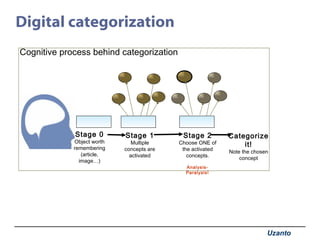Tag Camp 2005
- 1. Digital categorization Stage 1 Multiple concepts are activated Stage 2 Choose ONE of the activated concepts. Categorize it! Note the chosen concept Stage 0 Object worth remembering (article, imageâĶ) Cognitive process behind categorization Analysis-Paralysis!
- 2. Tagging is simpler Stage 1 Multiple concepts are activated Tag it! Write down all activated concepts Stage 0 Object worth remembering (article, imageâĶ) Cognitive process behind tagging
- 3. Tagging: Input versus Output Output Structure Input Effort Low High Low High Tag Clouds Hierarchical categorization Facets Clusters Collaborative Filtering If we could get to Facets / clusters from tags, it would be best of both worlds
- 4. Getting at structure through tags: (a) Card Sorting http://www.rashmisinha.com/archives/05_02/tag-sorting.html
- 5. Getting at structure: (b) Collaborative Filtering Challenges with Input: Getting lazy users to provide input (some indication of interest) Implicit (infer user intention from behavior). e.g., past purchasing behavior on Amazon Explicit (powerful, difficult to get people to rate stuff) e.g., ratings on Pandora, MediaUnbound) Challenges with interface Hard to convey what system is doing (no direct cause & effect as with search) Need to make system logic transparent (e.g., Amazon) Users who liked X, also liked Y Users who searched for X, also liked Y Users who bought X, also bought Y
- 6. Varieties of Collaborative Filtering with Tags Tags as an indicator of interest Tagged url as input, url as output People who like this url also like these other urls Tagged
- 7. Using tags as semantic information (with CF algorithms) Tags as input: Tags as output (People who use similar tags also use) Tagged urls as input: Tagged urls as output People who tagged similar urlsâ also tagged these urls Tag-url conjunction as input: Tagged urlâs as output People who tagged similar urlâs with similar tags, also tagged other urlâs with same tags
- 8. User Experience in such Search/Browse interfaces More of a controlled experience Every movement (forward, making a turn, backwards) is a conscious choice. (need information at every step) User might make mistakes, and retract (go back) a step or two or start again. Each of these is a conscious choice. Like being in control of a car
- 9. User Experience with Recommender Systems -user has less control over specifics of the interaction. System does not provide information about specifics of action more of the black box model (some input from user, output from systems). Like riding a roller-coaster
- 10. Tags & Clusters This idea is not new!
- 11. Clusters on Flickr Positives: No effort to name the clusters (makes clusters easy to understand) No fancy visual ways to show the clusters, simple text and image based Clustering tags, rather than items (computationally easier, easier to understand( No Other or Misc category Negatives Hard to understand the overall space and the individual categories Much harder to do with anything but images
- 12. Tags & Facets (the holy grail?) You have several orthogonal classifications. For example, Wine.com Wine can be described by type, region, price, vintage. Instead of putting all this in one large hierarchy, you can have several hierarchies Natural afffinity between tags and facets With tags you donât need to know where stuff lives, just know a few of its descriptors You can have as many facets as you want There are multiple ways to access a piece of content
- 13. From tags to Facets More than one way Compute facets from tags in some intelligent manner RawSugar Uses tags Some sort of a taxonomy at the back end to make sense of tags http://www.rawsugar.com/collections/oferben
- 14. Chandler approach People tag mail and other items Can promote tags to facets
Editor's Notes
- A lot of psychologists have spent a lot of time understanding categorization. This is kind of what we understand of it. When you talk to people about tagging, they do not talk about a different type of association. They talk aboiut the fact that they do not have to make one decision. SO why is this decision so hard. For those who say catgeorization is hard, its something we do all the time. We walk into the room and recognize a chair. Every decision we make is an act of categorization, a decision about is-ness. SO why is it so hard in digital life. Just because we make a decision about is-ness, does not mean that we cannot associate it with anything else. (this is a chair, but its also big, red etc.) Category structures in our mind our dynamic and ever evolving. Tomorrow, I might call this a table. There is no cultural consensus around categorization decisions we are making. Information overload. Too many categorization decisions. Categorization interfaces suck! We are commitment shy. Donât want to make a decision.














